Stock (Matthiola incana) for the Farmer Florist
Stock (Matthiola incana) is a fragrant, spiky flower. A member of the Brassicaceae family, it is suitable for cool-season production. Double flowers are 1¼ inch wide and appear in close clusters along 6–8 inches of the stems. The overall length when cut is 12–28 inches. The main colors of stock are white, red, pink, cream, purple, and yellow.
Production
Stock seed germinates in 7–14 days at 65–75°F. Transplanting plugs is recommended for field production. Sow 8–10 weeks before transplanting. If direct- seeding, sow after last frost. Space plants on 6-inch centers.
As stock is an annual, it is suitable for most USDA hardiness zones. High tunnel crops can be produced in approximately 12 weeks, transplanting around December 1 and harvesting in early- to mid-February. Alternate plantings every 1–2 weeks to extend harvests.
Unlike snapdragons (where the first, premium stem can be harvested, encouraging smaller bloom spikes from side shoots), stock plants are finished once stems are harvested.
Stock prefers full sun exposure; when springtime temperatures begin to rise, it stops producing marketable flowers. Some stock plants will have single flowers rather than the more desirable doubles.
Stock can be sensitive to potassium deficiency, the symptoms of which occur at flowering time and manifest in brown leaf tips and margins. Good plant nutrition is necessary for better quality; however, high levels of nitrogen can cause weak stems. A soil test is recommended to determine what, if any, amendments are needed.
Aphids (Figure 1) and thrips can attack stock plants in production. Diamondback moths, flea beetles, and springtails can also be problematic.
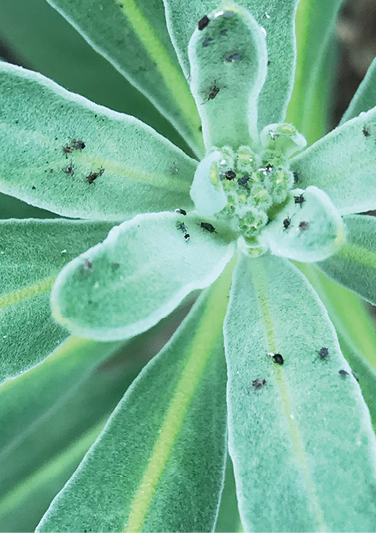
Figure 1. Aphids on immature stock.
Weeds can be avoided if beds are covered in white plastic mulch, which reflects sunlight and keeps roots cool. If no mulch is used and weeds become problematic in production, be sure to use a herbicide registered for use on stock. One suggested chemical control is trifluralin (Treflan), a pre-emergence (applied before planting) herbicide that controls annual grasses and a few broadleaf weeds for about 6–8 weeks. It is volatile and must be incorporated by irrigation immediately after application. The granular formulation is most often used to reduce vapor losses. Treflan is probably the safest herbicide on transplanted stock. Additionally, bensulide (Betasan) controls crabgrass, annual bluegrass, other annual grasses, and a few broadleaf weeds for 3–4 months.
It is the user’s responsibility to follow label instructions. You can find herbicide labels at www.cdms.net, www.bluebooktor.com/index.html and www.greenbook.net. Review labels before purchasing a product. Some labels provide scientific names and common names of plants, some list common names, and some list a combination. You may also contact your county MSU Extension agent for an update on herbicides labeled for flower production. Chemical registrations and approved uses change periodically.
Harvest and Handling
Harvest stems when one-third to one-half of the florets on the stem are open. The rest of the florets should be showing good color and size.
It is important to handle cut stems carefully to prevent damage and rapid decline. Bruising and breaking of flowers destroys their aesthetic and economic value, and wounded plant tissue increases the production of ethylene gas. Ethylene is a natural plant growth hormone that accelerates maturation of flowers and greatly shortens vase life. Stock is particularly sensitive to ethylene gas exposure. Treat stems with ethylene inhibitors such as 1-methylcyclopropene (1-MCP, trademark name EthylBloc) or silver thiosulfate (STS, marketed under the name AVB from Pokon & Chrysal) before storing or marketing. Condition overnight in very cold water.
Stock stems are best kept at 36–41°F. At these temperatures, they can be held up to 2 days without water, although immediate placement into water is recommended. Hold stock in the dark to avoid stem elongation. Prolonged refrigeration can result in loss of fragrance.
Stock stems are very dense, making water penetration difficult and shortening vase life. If the thick, white, fibrous base remains, cut it away. Change the water and recut the ends frequently. Stems should be placed in water immediately. Vase life is typically 7–10 days.
Cultivar Recommendations
Iron Series
Katz Series (available in apricot, blue, pink, white, purple, rose pink, rose, and yellow from Johnny’s Selected Seeds)
Design Applications
Arrangement
Vase designs of stock can be effectively used in pairs, flanking an altar (Figure 2). An upright, footed vase lifts the design higher, making the design work well for a buffet setting. This design requires no specialized mechanics. First, remove any foliage that might be immersed in the vase water, but keep remaining leaves intact. Start by adding stems in a spiral pattern, allowing first placements to rest on the rim of the container. Continue the pattern, making sure no foliage falls below the water line. The design can be made on-site or in the studio.
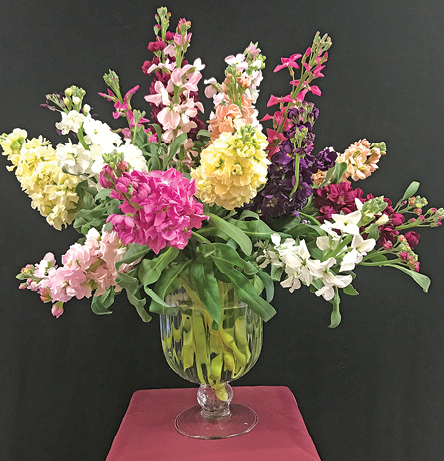
Figure 2. Stock vase arrangement.
Centerpiece
A simple, hand-tied bouquet of stock provides fragrance and color for a guest table (Figure 3). Fill a 5-inch-diameter glass bubble-bowl two-thirds full with flower food solution. Bind approximately 10 stems with paper-covered wire, cut the stems, and place into the vase. Cut stems to about half the container depth, and allow the flower heads to rest on the container rim to stabilize the design. Never pick up a bubble-bowl by its rim; the glass can easily break.
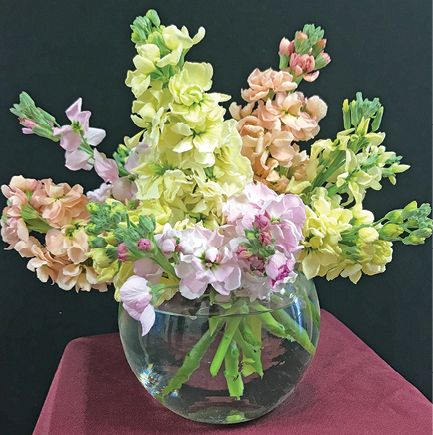
Figure 3. Stock centerpiece.
Flowers to Carry
Since stock is a line material, it is well-suited to styling as an arm bouquet or presentation bouquet (Figure 4). When carried, the arrangement is cradled in the crook of the arm. This particular design is constructed as a hand-tied bouquet, beginning with the longest placements in the back. The back of the design is relatively flat. Place successively larger stock flower heads closer to the focal area of the design to create emphasis and rhythm. Instead of culling curved, bent stems, use them away from the focal area. Tie the bouquet with paper-covered wire, waterproof tape, raffia, or another binding material and overwrap with ribbon. Coat the finished design with anti-transpirant spray (e.g., Crowning Glory, Chrysal Glory).
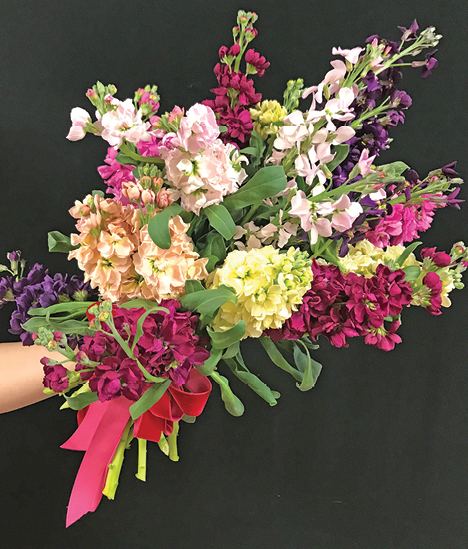
Figure 4. Arm bouquet.
Corsage/Boutonnière
Stock is a natural choice for flowers to wear because of its fragrance. Glue stock blossoms to 12-gauge aluminum craft wire frames using floral adhesive (Figure 5). Once completed, mist with anti-transpirant spray, allow petal surfaces to dry, and then enclose designs in plastic bags or boxes to maintain freshness.
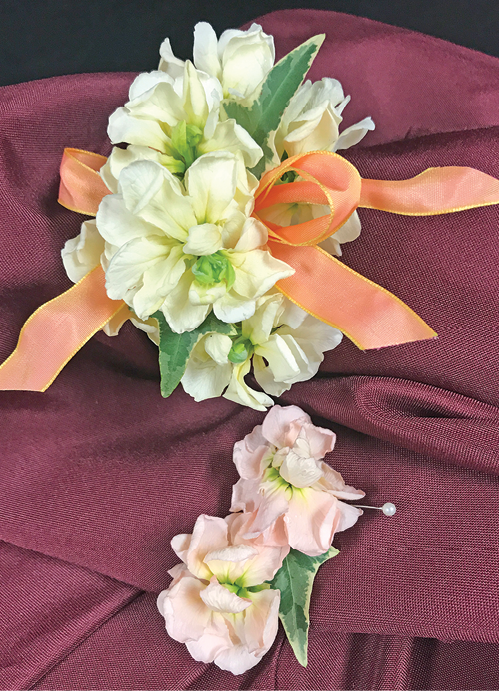
Figure 5. Corsage and boutonnière.
References
Hefferman, C. (2002). Flowers A to Z: A practical guide to buying, growing, cutting, arranging. New York, NY: Harry N. Abrams Inc.
Johnny’s Selected Seeds. (2018). Retrieved from http://www.johnnyseeds.com/content-search/?q=stock
Post, P. (2006). Emily Post’s wedding etiquette (5th ed.). New York, NY: HarperCollins Publishers Inc.
Stevens, A. B. (1998). Field grown cut flowers: A practical guide and sourcebook, commercial field grown, fresh, and dried cut flower production. Edgerton, WI: Avatar’s World.
Smith, T. (2002). Weed management for outdoor cut flowers. University of Massachusetts Center for Agriculture, Food, and the Environment. Retrieved from https://ag.umass.edu/greenhouse-floriculture/fact-sheets/weed-management-for-outdoor-cut-flowers
Vaughan, M. J. (1988). The complete book of cut flower care. Portland, OR: Timber Press.
USDA, NRCS. (2018). Plants database. Retrieved from https://plants.sc.egov.usda.gov/java/
Special thanks to Tanis Clifton, Happy Trails Flower Farm, Dennis, Mississippi, for reviewing this publication and Patrick Broussard, Susan Deblanc, and Corey Wheeler, MSU Coastal Research and Extension Center, for their assistance.
The information given here is for educational purposes only. References to commercial products, trade names, or suppliers are made with the understanding that no endorsement is implied and that no discrimination against other products or suppliers is intended.
Publication 3252 (POD-08-21)
By Christine Coker, PhD, Associate Extension/Research Professor, and James M. DelPrince, PhD, Assistant Extension Professor, Coastal Research and Extension Center.
The Mississippi State University Extension Service is working to ensure all web content is accessible to all users. If you need assistance accessing any of our content, please email the webteam or call 662-325-2262.





